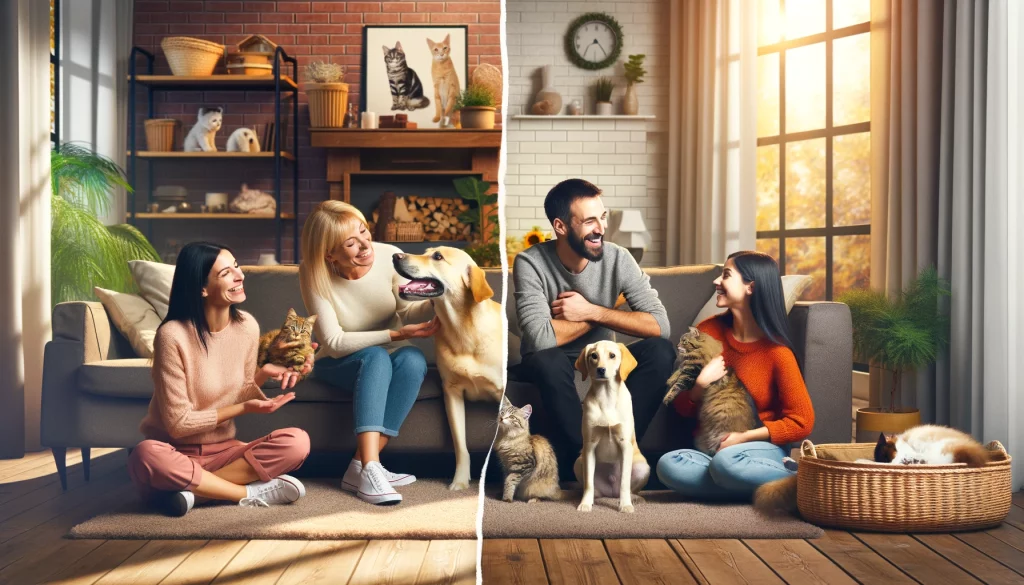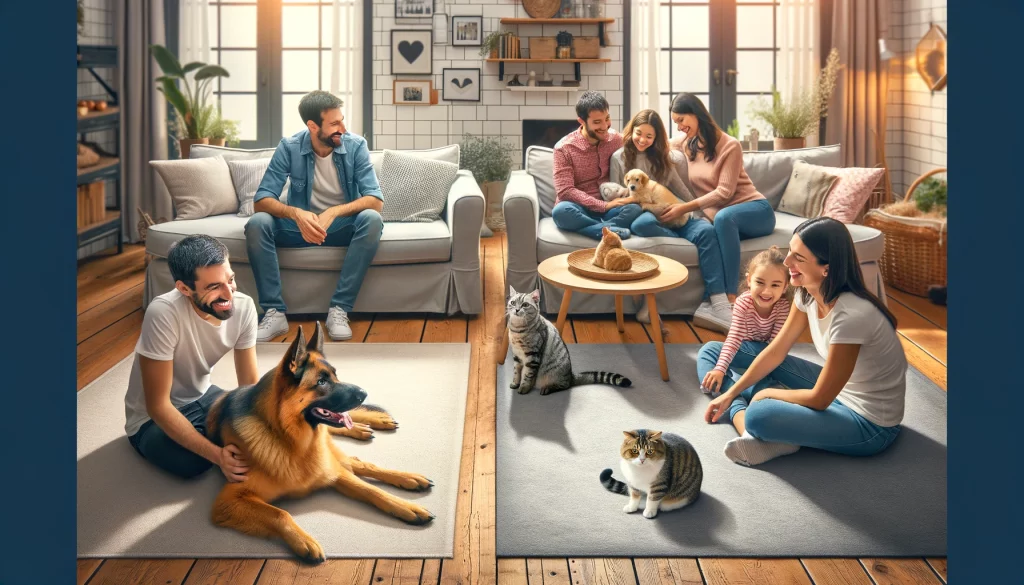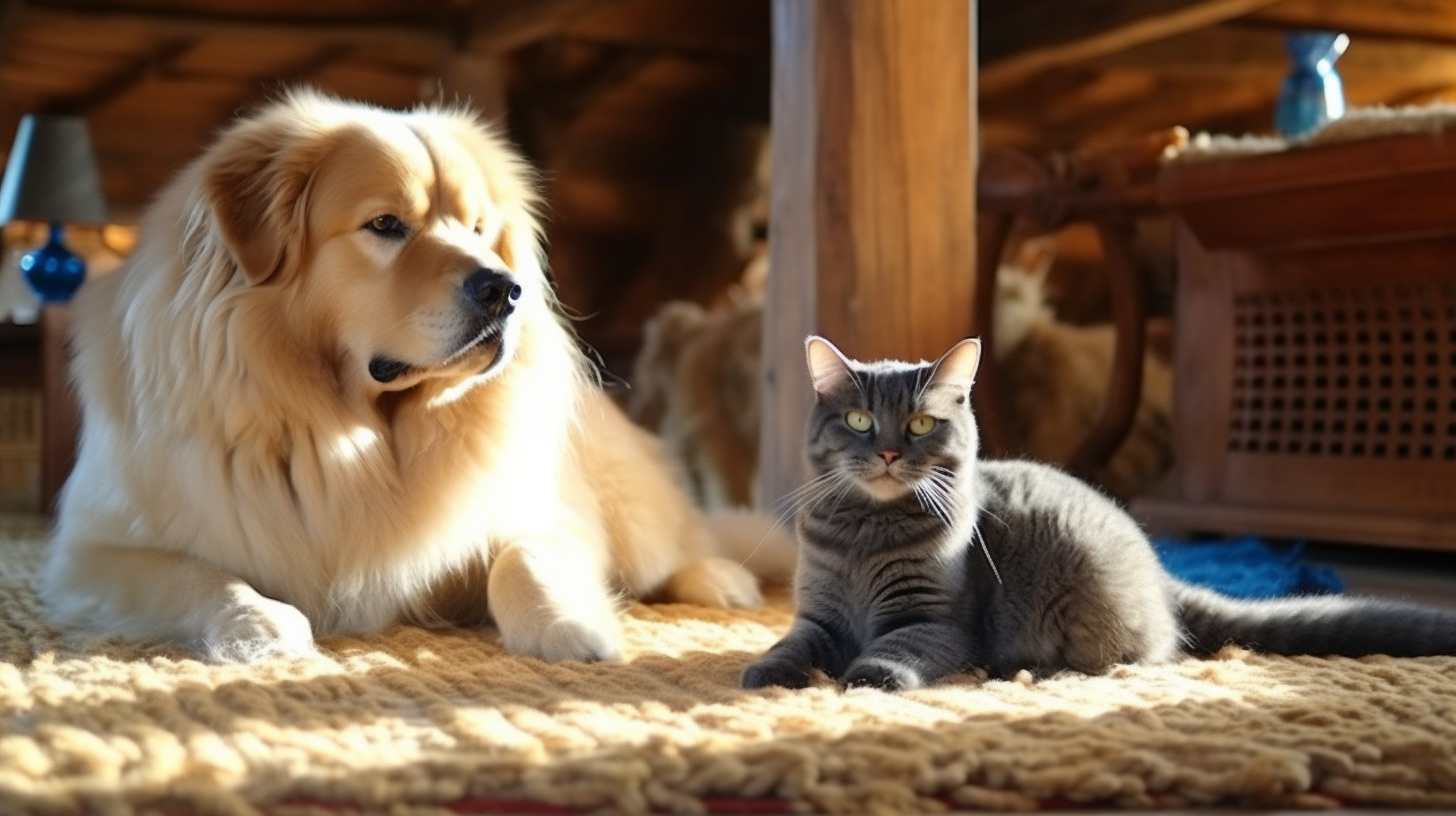Embarking on the thrilling yet daunting journey of selecting a family pet involves navigating the intricate landscape of feline and canine companionship. Unveiling the complexities of lifestyle alignment, caregiving commitments, child compatibility, and behavioral nuances, this article endeavors to illuminate the path, empowering you to decide between the enchanting allure of cats and the loyal camaraderie of dogs for your family.
Lifestyle Considerations
The pivotal consideration in the delicate balance of pet selection lies in deciphering the intricacies of your family’s lifestyle. With their innate independence and lower demands for attention and exercise, cats seamlessly integrate into bustling schedules or confined spaces. In contrast, dogs’ friendly and energetic nature thrives on consistent interaction and outdoor escapades, making them an ideal match for active families reveling in communal exploits.

Maintenance and Care
Navigating pet care nuances reveals intriguing distinctions between cats and dogs. Cats, paragons of cleanliness and independence, impeccably manage their grooming and bathroom affairs with an innate finesse, primarily utilizing litter boxes. The low-maintenance aura extends to bathing duties. Meanwhile, with their vibrant spirit, the canine companions necessitate a more hands-on approach. Regular grooming, indulgent baths, and invigorating outdoor walks are integral to their well-being and bathroom etiquette. A symphony of vet visits and vaccinations orchestrates the routine care tableau, contributing to the dynamic cadence of dog companionship.
Compatibility with Children
Contemplating the harmonious coexistence of pets and children introduces a nuanced perspective. The feline companions, characterized by an inherent reserve, may exercise caution in the exuberant presence of energetic children. Yet, profound connections can blossom in a symphony of gentleness and respect. A tapestry of patience and playfulness unfolds on the canine front, especially within select breeds. Dogs emerge as stalwart companions, imparting joy and a reassuring sense of security. Within this tableau, the temperament and size of the canine partner become pivotal considerations, harmonizing with the imperative to instill responsible and respectful interaction within the younger members of the familial ensemble.
Training and Behavior
Navigating the realms of training and behavior unfurls distinct considerations in the tapestry of pet selection. Cats, creatures of inherent autonomy, demand less training, navigating life instinctively. Yet, introducing suitable scratching posts becomes crucial to channel their innate hunting proclivities and safeguard household furniture. In the canine domain, a canvas of consistency beckons as dogs, akin to eager apprentices, flourish under steadfast training and socialization. Through this concerted effort, dogs metamorphose into well-mannered household denizens, responsive to commands, adept at leash etiquette, and ready to regale with an array of endearing tricks.
Final Verdict
The dichotomy between a feline companion and a canine confidant rests on the intricate interplay of familial proclivities, lifestyle dynamics, and temporal investments. Cats, epitomes of self-sufficiency, seamlessly weave into the fabric of low-maintenance living, gracefully adapting to compact abodes. In the canine realm, the tapestry is woven with threads of companionship, demanding more temporal devotion, rigorous exercise routines, and diligent training. Yet, the reciprocal gifts include unwavering loyalty, boundless playfulness, and a sentinel’s embrace, fortifying the familial haven.
Important factors:
They determine the ideal addition to your familial tableau, whether a feline confidant or a canine comrade, entails a nuanced evaluation. With their enigmatic charm, cats offer a blend of independence and affection, requiring less hands-on care. Dogs, embodying boundless enthusiasm, proffer unwavering loyalty and a zest for shared adventures, albeit with more intricate needs. This exploration delves into the unique merits of feline camaraderie and canine companionship, aiming to illuminate the path toward a well-informed decision tailored to your family’s ethos.
Factors to Consider:
Deciphering the optimal addition to your familial symphony, be it a feline muse or a canine confidant, necessitates a nuanced evaluation. With their enigmatic allure, cats offer a tapestry of independence and affection, demanding less hands-on care. Dogs, embodying boundless enthusiasm, proffer unwavering loyalty and zeal for shared escapades, albeit with more intricate needs. This exploration navigates through the unique virtues of feline camaraderie and canine companionship, aspiring to illuminate the path toward a discerning decision tailored to your family’s ethos.

Benefits of Having a Cat as a Family Pet:
- Low Maintenance:
Deciphering the optimal addition to your familial symphony, be it a feline muse or a canine confidant, necessitates a nuanced evaluation. With their enigmatic allure, cats offer a tapestry of independence and affection, demanding less hands-on care. Dogs, embodying boundless enthusiasm, proffer unwavering loyalty and zeal for shared escapades, albeit with more intricate needs. This exploration navigates through the unique virtues of feline camaraderie and canine companionship, aspiring to illuminate the path toward a discerning decision tailored to your family’s ethos.
- Calming Presence:
With their calming aura, cats contribute to stress reduction and anxiety alleviation, enhancing the family’s overall well-being.
- Playful Companionship:
With their calming aura, cats contribute to stress reduction and anxiety alleviation, enhancing the family’s overall well-being.
- Apartment-Friendly:
Cats are well-suited for apartment living or limited outdoor spaces as they can comfortably thrive indoors.
View another article : Film or Serial: Which One is Better for Free Time?
Advantages of Owning a Dog as a Family Pet:
- Loyal and Protective:
With their loyal and protective nature, dogs can offer a strong sense of security, forming enduring bonds with their owners and benefiting the entire family.
- Active Lifestyle:
With their need for regular exercise, dogs can promote a more active lifestyle for the entire family. Engaging in daily walks and playtime benefits physical health and contributes to mental well-being.
- Socialization:
Dogs thrive on social interaction and can be crucial in promoting socialization skills, particularly in children. Their enjoyment of being part of family activities and outings enhances a sense of companionship and shared experiences.
- Training Opportunities:
With their highly trainable nature, dogs can master an extensive array of commands and tricks, fostering an enjoyable and rewarding experience for the entire family.
Considerations for Choosing Between a Cat and a Dog:
- Allergies:
Before introducing a pet into your home, particularly if family members have allergies, exploring hypoallergenic breeds or seeking guidance from a healthcare professional is crucial.
- Time and Commitment:
Dogs typically demand more time and attention than cats, necessitating a thorough evaluation of your family’s schedule to ensure the ability to meet the dog’s needs for care and companionship.
- Space:
Dogs, particularly larger breeds, demand more space for movement and play, while cats exhibit greater adaptability to smaller living spaces.
- Financial Considerations:
Owning a pet entails various expenses, including food, veterinary care, grooming, and supplies. Evaluate your budget to ensure you can adequately provide for your chosen pet.

conclusion
Conclusively, both cats and dogs present fantastic options for family pets. Cats are excellent companions for families with hectic schedules or constrained living spaces, offering low-maintenance care and independence. On the other hand, dogs are well-suited for families with the capacity to invest time and effort in their care and training, providing loyalty and playfulness. When deciding, consider your family’s lifestyle, the level of care you can afford, and compatibility with children. Remember that, regardless of your choice, fostering a loving and nurturing environment is pivotal for cultivating a joyful and harmonious relationship with your new four-legged companion.
Dogs
- Dogs are pack animals. They are social creatures that thrive on companionship.
- Dogs are loyal and loving. They form strong bonds with their owners and make great companions.
- Dogs can be trained to do a variety of tasks. They can be trained to perform tricks, help with chores, and even provide assistance to people with disabilities.
- Dogs require regular exercise. They need to be walked, played with, and run on a regular basis.
- Dogs can be expensive to care for. They need food, toys, veterinary care, and other supplies.
Cats
- Cats are independent creatures. They are not as social as dogs and do not require as much attention.
- Cats are relatively low-maintenance. They do not need to be walked or played with as often as dogs.
- Cats can be clean and tidy animals. They groom themselves regularly and do not typically make a mess.
- Cats can be aloof and independent. They may not be as affectionate as dogs.
- Cats can be destructive. They may scratch furniture, climb curtains, and knock over objects.
Things to consider when choosing a pet:
- Your lifestyle. Do you have time to walk, play with, and groom a pet?
- Your budget. Can you afford the cost of food, toys, veterinary care, and other supplies?
- Your family’s needs. Do you have young children or other pets?
- Your allergies. Are you allergic to dogs or cats?
Here are some sources that you can use to find more information on dogs and cats:
- The American Kennel Club (AKC)
- The American Society for the Prevention of Cruelty to Animals (ASPCA)
- The Humane Society of the United States
Please note that owning a pet is a big responsibility. Before you get a dog or cat, do your research and ensure that you are prepared to provide the animal with the care it needs.
FAQ
Are cats or dogs better for families with young children?
It depends on the individual family, but generally, dogs are known to be more suitable due to their loyal and protective nature.
Do cats or dogs require more maintenance?
Dogs generally require more maintenance as they need regular exercise, grooming, and training, whereas cats are more independent and self-sufficient.
Can cats or dogs be kept in small living spaces?
Cats are more adaptable to small living spaces, such as apartments, as they can be kept indoors. However, some dog breeds are suitable for smaller spaces too.
Which pet is more suitable for allergy sufferers?
For individuals with allergies, hypoallergenic cat or dog breeds are recommended, as they produce fewer allergens and may be better tolerated.

